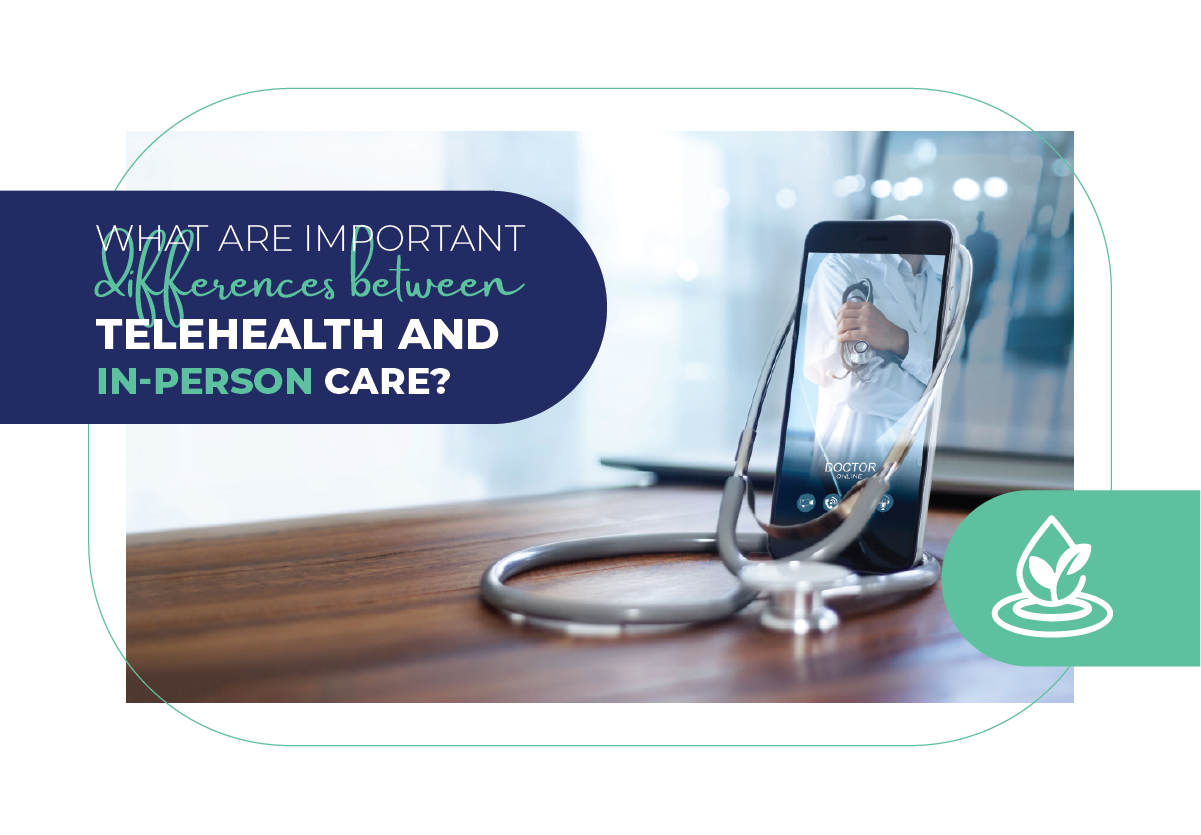Telehealth vs In Person
When it comes to your health, you want the best care possible, of course. With so many decisions to make, it can be challenging to determine if you are receiving the most suitable care for your situation.
People today are always looking for the best healthcare, which brings up the question of whether to choose in-person care or telehealth.
The answer is different for each person. There are some similarities between these healthcare solutions, but there are also some important differences.
To ensure that everyone gets good mental health care, the Atlantis Wellness Center’s online programs are flexible and easy for busy people or people who cannot get to a clinic in person.
What are important differences between telehealth and in-person care? Let us look more closely at each choice before we compare them.
What Is Telehealth?

What does telehealth really mean? In telehealth, patients and doctors can talk to each other through technology instead of being in the same room. This type of care is also known as telemedicine.
When most people think of telehealth, they picture video calls with doctors and nurses. Telehealth can be done in more than one way. Videoconferencing is just one of them. There are three main types of telehealth: monitoring patients from afar, synchronously, and asynchronously.
After learning what telehealth is, do you want to know how to have a virtual visit with your doctor? Tech for telehealth comes in many forms, such as
- Landline or Cell Phones: Telehealth includes visits, calls, and texts with healthcare providers over the phone.
- Internet-Connected Wearables: Smartwatches, pacemakers, and other health devices that you can put on can send important data to a server online so that a professional can look it over.
- Store-and-Forward Imaging: Video calls let people talk to each other in real-time, but store-and-forward imaging works in the background, so patients can send photos or videos to their healthcare providers to look at later.
Telehealth is becoming more useful as technology improves. For example, remote surgeries, in which surgeons do operations from far away, show how telemedicine could change the way modern healthcare is provided.
What Is In-Person Care?

Patients have usually gone to a doctor’s office, a counselor’s office, or a treatment center in person.
Patients have to go to a clinic or office to meet with a healthcare provider face-to-face.
For example, the following medical procedures usually still need to be done in person:
- Imaging tests like X-rays
- Hands-on physical examinations
- Surgeries
Patients and healthcare providers could only talk to each other in person, so that is how healthcare has always been done.
However, as technology has improved, telehealth has become an important addition to in-person appointments.
This has made healthcare easier for people all over the world to access.
What are Important Differences Between Telehealth and In-Person Care?
Accessibility and Convenience
Telehealth
- Accessibility: Because telehealth does not depend on location, people who live in remote or underserved areas can get medical care. People can talk to specialists they might not be able to reach in any other way.
- Convenience: Patients can schedule telehealth appointments around their schedules, so they do not have to take time off work, travel, or wait in clinics.
In-Person Care
- Direct Access to Services: Tests like lab work, x-rays, and physical exams can only be done in person, not over the phone or online.
- Personal Interaction: Having a consultation with someone in person is more personal, which can be reassuring and comforting, especially for people who do not like talking to computers or do not take them very seriously.
Quality of Care
Telehealth
- Some Conditions Work Well: Telehealth is great for mental health services, follow-ups, consultations, and taking care of long-term conditions. It makes it easy to change treatment plans quickly and keep an eye on things all the time.
You can consider Atlantis Wellness Center for online anxiety treatment.
- Technology Dependence: Problems with technology, like slow internet connections, can lower the quality of care by making it harder to communicate and the consultation less useful.
In-Person Care
- Comprehensive Assessment: When you see the doctor in person, you can get a full physical exam and start diagnosing right away. This can help you get a diagnosis and treatment plan more quickly.
- Better for Hard Cases: People who are very sick often need to have physical exams, diagnostic tests, and other procedures that can only be done in a hospital.
Cost and Insurance
Telehealth
Cost-Effective: Telehealth today can save money for both patients and healthcare providers by cutting down on the need for physical infrastructure and travel costs.
Coverage by Insurance: Since the COVID-19 pandemic, insurance coverage for telehealth services has gotten better, but it can change from provider to provider and state to state.
In-Person Care
- Costs Are Higher: Getting care in person may cost more because of facility fees, travel, and time away from work.
- Broad Insurance Acceptance: Traditional in-person visits are generally well-covered by most insurance plans, making them more predictable in terms of cost.
Patient-Provider Relationship
Telehealth
- Relationship Building Remotely: Regular virtual check-ins through telehealth can help patients and providers build strong relationships, but it can be hard to get to know each other at first without meeting in person.
- Continuity of Care: Telehealth supports continuous care by letting people with chronic conditions get regular check-ups and be closely watched.
In-Person Care
- Stronger First Connection: Being there in person for care helps build a strong, personal connection right from the first visit, which can help build trust and communication.
- Body Language and Facial Expressions: Physical visits allow doctors and nurses to better read nonverbal cues like body language and facial expressions, which can aid in diagnosis and treatment.
In conclusion, what are important differences between telehealth and in-person care?
Choosing between telehealth and in-person care depends on individual needs and circumstances.
Telehealth offers convenience and accessibility, especially for routine consultations and chronic condition management, while in-person care provides comprehensive assessments and personal interaction essential for complex cases.
Both have their unique advantages, making them valuable options in modern healthcare. Ultimately, the best choice varies for each person and situation.
FAQs
How long to wait for telehealth appointment?
Patients usually have to wait about 20 minutes for a telehealth visit. However, wait times can be different depending on things like the availability of providers and how urgent the medical condition is.
Can telehealth appointments help reduce overall wait times for healthcare?
Yes, telehealth appointments can help cut down on wait times because providers do not have to travel as much and can see more patients in a day.
For instance, psychologists might be able to see ten more patients each week if they offer telehealth appointments.
What factors affect wait times for telehealth appointments?
Availability of providers, the seriousness of the illness, the day and time of the week, and technical problems can all affect how long you have to wait for a telehealth appointment.







No comment